Patrick Brown is a Toronto based criminal injury lawyer-and he was recently on CBC Radio’s Ontario Today discussing something we at Price Tags have pondered-Where the heck is the criminal sentencing and consequences when at fault drivers maim and kill pedestrians and cyclists?
Mr. Brown maintains that in Ontario “special status” has been given to drivers, meaning that it is circumstantial whether causing a fatality is a crime. “Certainly if there’s drinking involved or if there’s an individual in a hit and run or there’s racing and I would also consider distracted driving a crime and that means there was intent to do a behavior that was reckless and careless and resulted in loss of a life”.
But what happens with drivers that say that their gas pedal gets stuck, or other excuses? “There’s a responsibility when you’re driving the car that you don’t act recklessly, that you make sure that your sandal does not get caught in the accelerator and that you prevent your vehicle from crossing lanes and killing someone. We have to have a system that reacts to these situations in a different manner than we’re presently watching. Erica Stark was standing on a sidewalk when the car went up over the curb and killed her. The response to that by our system was a $1,000 fine.”
Road violence is surprising in that the maiming and killing of vulnerable road users does not have serious consequences for the driver. Mr. Brown notes that he has seen instances where a seriously injured pedestrian is given a jaywalking ticket while the car driver responsible for the injuries is never charged. But, under Ontario law, if a crosswalk is more than 100 metres away, a pedestrian can legally cross a road. “That’s the systemic type of outlook that happens at times in relation to drivers and pedestrians. “

Patrick Brown sees speed reduction as absolutely necessary— “speed kills and is the number one factor in these pedestrians getting hit and killed and it would make a significant difference if we reduced the speed limits. And most importantly, vulnerable road user laws — these have already been passed in at least 10 of the states down south, and these laws say that if you hit a pedestrian, a cyclist, somebody using a mobility aid, anybody who’s vulnerable, doesn’t have that protection of airbags and collapsible steering wheels, that you’re going to be subject to added penalties on top of what you’re already going to face.”
After practicing this area of law for 20 years, Brown says that there is “a repetitive result,’ where individuals who are clearly negligent, careless and reckless and kill and seriously injure people” have been given a slap on the wrist.” This needs to change, and it needs to change now. In Oregon, hitting a vulnerable road user results in a licence suspension, a mandatory driving course and up to 200 hours of community service, and a fine or jail. Mr. Brown maintains “A $500 fine to an individual may mean nothing, It’s like going out for dinner for a night. The fine is less than the dent in the car. But you actually make them proactively have to do something and reflect on their conduct, then you’re sending a message out of deterrence to all society — you have to pay particular attention when you’re near these individuals”.
In the 21st century it is time for us to treat road violence as a crime, require mandatory slowing of speeds neighbourhood wide, and deter driver inattention and behaviour. How do we ensure that all road users can safely and sustainably use our roads and streets?




